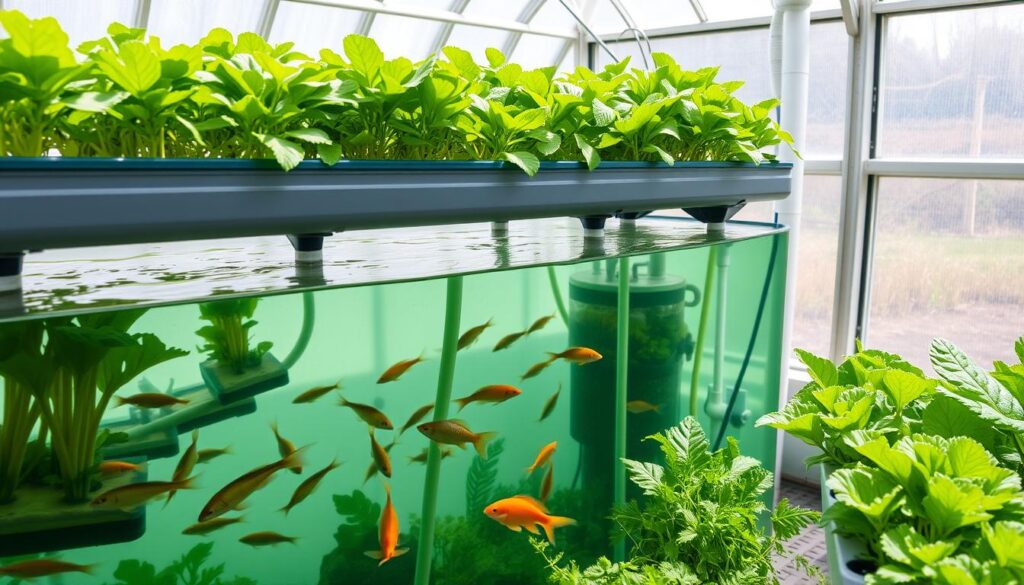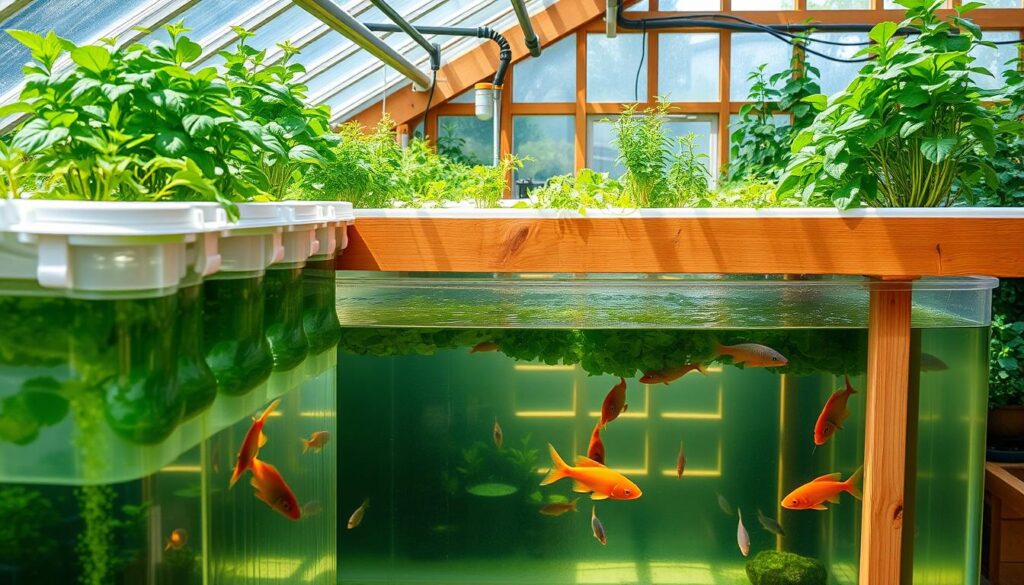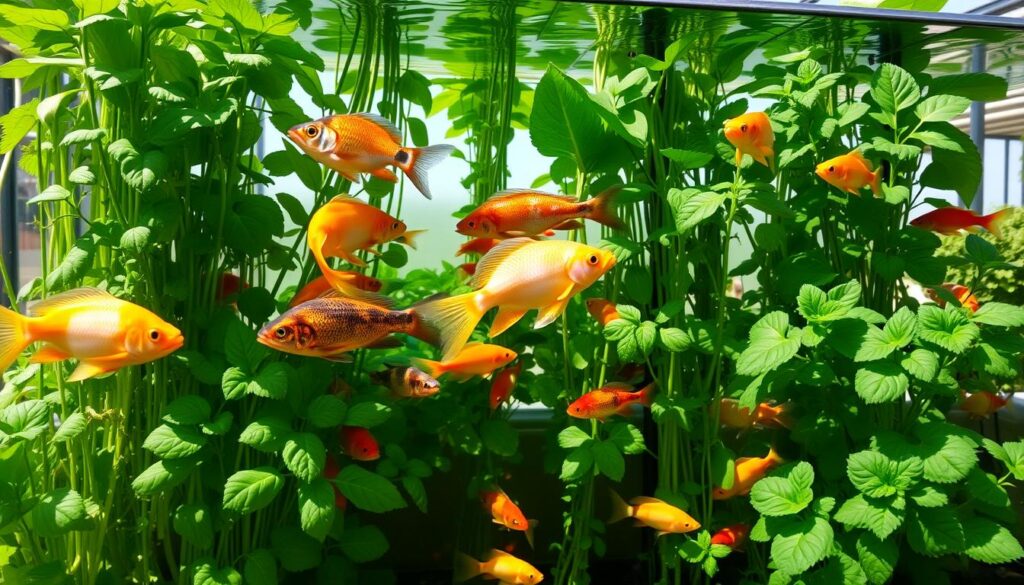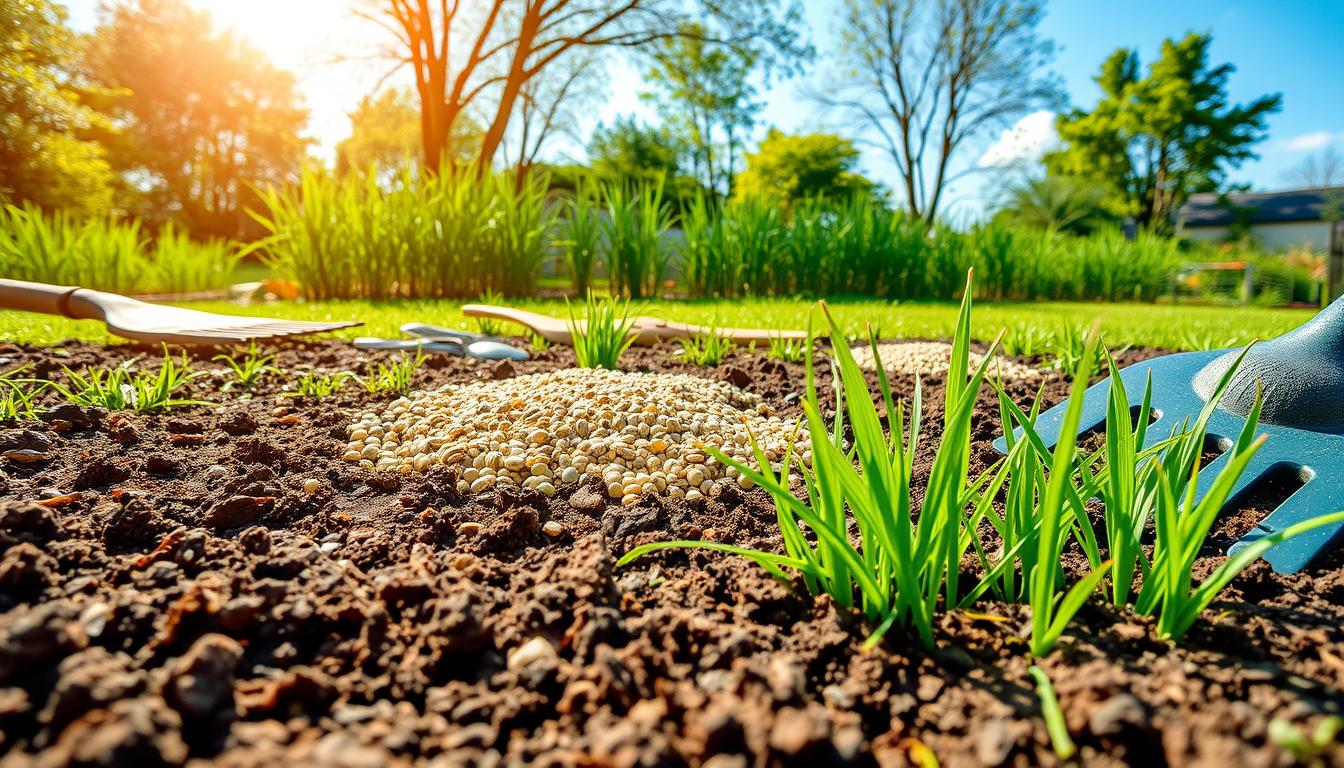Imagine a lush garden full of greens, tomatoes, and fish swimming below. This dream is now a reality with aquaponics. It’s a way to grow plants without soil. This method combines fish farming with growing plants, creating a balanced ecosystem.
More people want to farm sustainably. The aquaponics guide here shows how it tackles today’s farming problems. It highlights the need for efficient, soilless gardening.

Aquaponics saves space, water, and cuts down on waste. It’s key to our sustainable future. We’ll dive into aquaponics basics and how it changes food production.
Key Takeaways
- Aquaponics combines fish farming and plant cultivation to create a self-sustaining ecosystem.
- This method offers a feasible way of growing plants without soil, leading to higher efficiency in agriculture.
- Water conservation is one of the significant advantages of eco-friendly farming.
- Integrating aquaculture and hydroponics can enhance food security and sustainability.
- Aquaponics supports the principles of organic and sustainable farming practices.
Understanding Aquaponics and Its Process
Aquaponics is a new way to farm that combines fish and plants. Fish waste helps plants grow, and plants clean the water for fish. This system is all about balance and working together.
Learning about aquaponics shows us how it’s good for the environment. It’s also very efficient in growing crops.
What is Aquaponics?
Aquaponics is about fish and plants helping each other. Fish waste turns into nutrients for plants. This is different from hydroponics, where plants grow in water without fish.
In aquaponics, fish waste feeds plants, and plants clean the water. This makes a complete cycle.
How Aquaponics Works: The Science Behind It
The key to aquaponics is the work of beneficial bacteria. They change fish waste into nutrients for plants. This keeps plants healthy and the water clean.
By understanding this, we see how aquaponics uses resources well. It also has less impact on the environment than traditional farming.
The Secret to Growing Plants Without Soil: An Intro to Aquaponics
Aquaponics is a new way to garden without soil. It shows how we can save resources and grow more food. Learning about soilless gardening techniques can really change how we think about farming.
The Benefits of Soilless Gardening Techniques
More gardeners are choosing soilless systems like aquaponics. This choice has many benefits:
- Reduced water consumption: Aquaponics saves water by using it over and over again.
- Decreased need for chemical fertilizers: It uses natural nutrients, cutting down on synthetic fertilizers.
- Enhanced crop yield rates: Plants grow better and faster in these perfect conditions.
Overview of Sustainable Farming Benefits
Aquaponics is all about sustainable farming. It works with organic gardening to create a healthy ecosystem. Here are some key points:
| Aspect | Aquaponics | Traditional Farming |
|---|---|---|
| Resource Use | Efficient water and nutrient cycling | High water and fertilizer consumption |
| Soil Health | No soil degradation | Risk of erosion and nutrient depletion |
| Carbon Footprint | Lower due to reduced transport and chemicals | Higher due to conventional practices |
When we compare hydroponics vs aquaponics, aquaponics is special. It grows plants and raises fish together. This approach helps the environment and ensures food for everyone, showing the full benefits of this system.
Setting Up Your Aquaponics System
Creating a good aquaponics system needs careful planning. You must think about the key parts it needs to work well. The place you choose for your indoor setup is also very important. Let’s look at these important points in more detail.
Essential Components of an Aquaponics Setup
An effective aquaponics setup has several important parts. These parts work together to help fish and plants grow well. Here are the main components you’ll need:
- Fish Tank: This is the heart of the system, where fish live. The size depends on how big you want your setup to be.
- Grow Beds: These are where plants live and are connected to the fish tank. They let water rich in nutrients flow to the plants.
- Pumps: These are needed to move water between the fish tank and grow beds. This makes sure plants get the nutrients they need.
- Filters: Filters help clean the water by removing solid waste. This keeps the environment healthy for both fish and plants.
- pH and Nutrient Monitoring Equipment: This equipment helps you keep an eye on water quality. It’s key to keeping your system healthy.
Location and Space Considerations for Indoor Aquaponics
Choosing the right spot for your indoor aquaponics system is important. Several things should guide your decision:
- Light Exposure: Make sure plants get enough light, whether from the sun or artificial sources.
- Temperature Control: Keeping the temperature stable is crucial. Fish and plants have specific temperature needs.
- Access to Resources: Place the system near water and electrical outlets for easy access.
- Space Efficiency: Use vertical space to grow more without taking up too much floor space.

By using the right components and picking a good location, you can create a thriving aquaponics system. The right balance between fish and plants leads to a productive and sustainable setup.
Choosing the Right Aquaponics Fish and Plants
Choosing the right fish and plants is key for a good aquaponics system. Fish provide nutrients and help create a healthy environment for plants. The right choices can make your system more efficient and help plants grow better.
Best Fish for Aquaponics: Fish-Powered Plant Growth
When picking fish for your aquaponics system, look for species that do well in a controlled space. Some top picks are:
- Tilapia: These fish are tough and grow fast, making them great for beginners.
- Catfish: They can handle different water conditions, making them perfect for aquaponics.
- Trout: Trout like cooler water and are very productive, making them a good choice for aquaponics.
Choosing the right fish is important for plant growth. It helps keep the nutrient cycle strong in your system.
Optimal Plants to Grow in an Aquaponic System
Choosing the right plants for your aquaponics system is also crucial. Good options include:
- Leafy Greens: Lettuce and spinach grow fast and need less nutrients, making them ideal for aquaponics.
- Herbs: Basil, mint, and parsley do well in aquaponics. They get nutrients from the fish waste.
- Tomatoes: Tomatoes can grow well in aquaponics with the right care and support. They offer high yields.
Using the right plants with your fish creates a balanced ecosystem. This ensures both fish and plants thrive together.

Conclusion
Aquaponics is a game-changer for gardening. It combines fish farming with soil-less gardening. This approach tackles food production challenges in a new way.
It saves soil and boosts efficiency. This shows how aquaponics is changing farming for the better.
Using aquaponics can change how we garden. It leads to healthier plants and better care for our planet. By mixing fish farming with hydroponics, we can grow food sustainably.
We hope you see the potential of aquaponics. It’s great for both small gardens and big farms. It’s a smart way to grow food.
So, let’s explore aquaponics together. It’s a step towards a greener future. And it lets us enjoy fresh, homegrown food.
FAQ
What is aquaponics?
Aquaponics is a way to farm that combines fish farming and growing plants in water. Fish waste feeds the plants, and the plants clean the water for the fish. It’s a system where everything works together.
How does aquaponics work?
In aquaponics, water moves between fish tanks and plant beds. Fish waste is food for the plants. The plants clean the water, which then goes back to the fish tanks.
What are the benefits of aquaponics?
Aquaponics uses less water than traditional farming. It doesn’t need chemical fertilizers. It also grows more food and can be done in cities. It’s a green way to farm.
How do aquaponics and hydroponics differ?
Aquaponics uses fish waste as fertilizer, while hydroponics uses man-made nutrients. Hydroponics doesn’t involve fish. Both are soilless farming methods.
What equipment do I need to set up an aquaponics system?
You’ll need fish tanks, grow beds, pumps, filters, and pipes. These help keep the water moving. A good setup is key for healthy fish and plants.
What types of fish are best for aquaponics?
Good fish for aquaponics are tilapia, catfish, and trout. They grow well and are easy to care for. They help plants grow too.
What plants are optimal for an aquaponics system?
Good plants for aquaponics are leafy greens, herbs, and fruiting plants. They love the nutrient-rich water. They grow well in aquaponic systems.
Can I set up an aquaponics system indoors?
Yes, you can set up aquaponics indoors. You’ll need the right light, temperature, and space. This helps fish and plants thrive indoors.
How do I maintain the health of fish and plants in an aquaponics system?
Keep an eye on water quality and pH levels. Make sure the temperature is right and there’s enough oxygen. Feed the fish well to help plants grow.
Is aquaponics a sustainable farming method?
Yes, aquaponics is sustainable. It uses less water and space. It also cuts down on chemical use. It’s a green way to farm food in cities.




